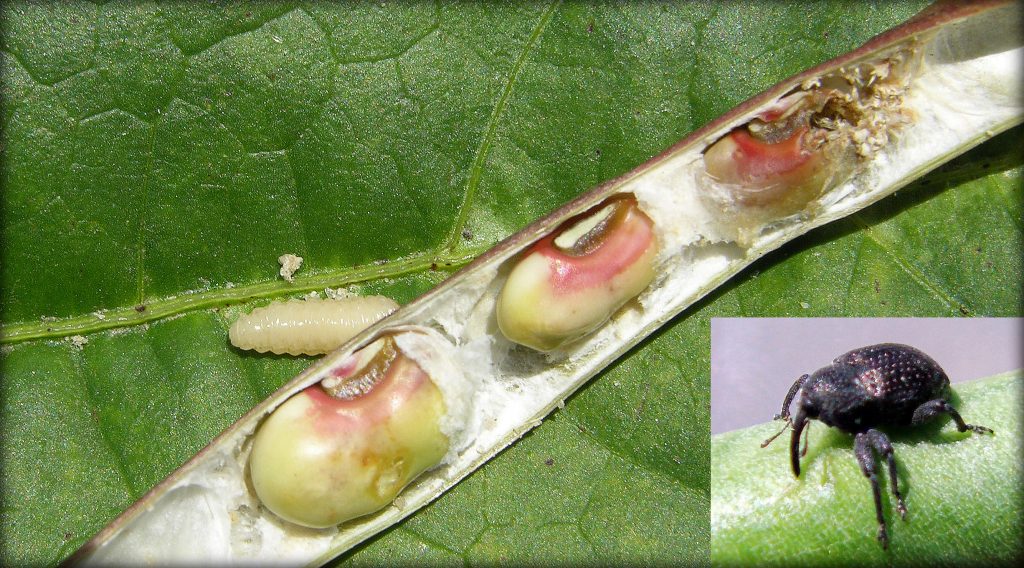
By Ashley Robinson
Southerners love cowpeas, also known as southern peas or black-eyed peas. Unfortunately, so do cowpea curculios, a weevil that wreaks havoc on peas grown in the Southeast. University of Georgia (UGA) researchers are working to eliminate the pest.
History of the Pest
David Riley, professor of Entomology at UGA, has been researching cowpea curculio for the past 10 years.
At the turn of the 20th century, Southern peas covered approximately 6 million acres across the Southeast. According to Riley, they were the primary legume grown for livestock feed until World War II, when soybeans took over.
“There’s a very interesting history behind the crop,” Riley says. “One hundred years ago, cowpeas used to be a massive crop, more like cotton. They were considered an agronomic crop, grown for legume grain for animal forage and feed as well as a vegetable crop.”
After the emergence of soybeans, the cowpeas that were used for livestock production disappeared. What was left of the peas was grown for food.
When Riley began working with UGA as a vegetable entomologist in 1996, he discovered that as cowpea acreage declined, so did cowpea curculio populations. As curculio issues died down, cowpea acreage made a comeback, peaking in 2015 at about 7,600 acres, according to UGA’s 2015 Farm Gate Value Report. As acreage made a comeback, though, so did curculio populations.
Research Progress and Management Options
Unfortunately, the cowpea curculio has become tolerant to pyrethroid insecticides which was the primary means of control during the flowering stage of the crop. However, in the 10 years that Riley has studied the pest, a lot of progress has been made.
“When all of your insecticide options are gone, then you have to start thinking outside the box,” Riley said.
“The most recent, big discovery that has been made is that cowpea curculio is very similar to the boll weevil in that is diapauses,” Riley says. “Diapause is a state of hibernation. During this process, the female weevils don’t develop eggs. They put on fat to survive the winter instead. This is something tropical weevils do because they don’t have any food to survive on during the winter.”
Riley recommends growers plant their crop for a late September pod set, to avoid damage.
New World Beans
Another recent discovery is that New World beans are not as affected by the weevil.
Five years ago, Riley came across a professor in Australia who was working on another cowpea project in Africa. The professor, T.J. Higgins, noticed that the New World bean, Phaseolus vulgaris (snap bean or pinto bean), wasn’t affected by this weevil. He tracked the reason down to a gene called alpha-amylase inhibitor. Amylase is the enzyme used to digest starch. An inhibitor stops that normal enzyme from working, so it’s harder to digest.
Higgins took the alpha-amylase inhibitor gene from the New World bean and put it into the Old World bean (cowpea). His results from this genetically modified pea show reduced weevil damage.
“The New World Beans have a natural resistance to weevils. They grew up together,” Riley said. “Cowpeas aren’t from the New World, so they don’t have the natural resistance.”
Although weevil-resistant peas would be ideal, it will be difficult to get them approved as the crop isn’t expensive enough and there isn’t enough acreage to warrant a big company getting involved.
“There is a practical consequence of just knowing the biology and knowing how these crops are,” Riley says. “If you use traps in the spring to see when the weevils are coming out of their overwintering sites, those weevils are very starved. Although they would prefer a cowpea, they will go after snap beans if that is all that is available.”
Since snap beans aren’t a good reproductive host for the pest, Riley suggests that growers set up traps for their area. They can determine when the weevils are on the move out of their overwintering sites. Then growers should plant snap beans first as a trap crop. Give it a month or so and force those weevils to try to lay eggs in the snap beans. Since it’s a crop with natural resistance, most of the eggs won’t develop.









